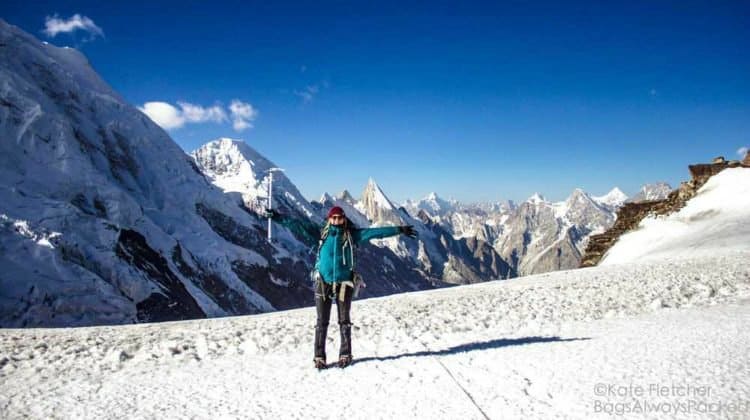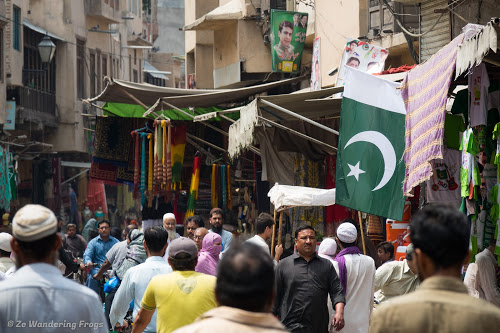Pakistan lies in the temperate zone. The climate is generally hot summers and cool or cold winters, and wide variations between extremes of temperature at given locations. There is little rainfall.
The coastal area along the Arabian Sea is usually warm, whereas the frozen snow-covered ridges of the Karakoram Range and of other mountains of the far north are so cold year round that they are only accessible by world-class climbers for a few weeks in May and June of each year.
Pakistan has are four seasons:
- December through February: Winters, A cool to very cold dry winter
- March to May: Spring, pleasant to warm
- June to September: Summers, rainy, monsoon to very hot
- October to November: Autumn, pleasant to cold windy
The onset, duration, and degree of intensity (warm to cold) of these seasons vary according to location. Below the major cities of Pakistan are mentioned from each region, to give you an idea of what to expect.
Islamabad

The climate in the capital city of Islamabad varies from very cold to extremely humid and hot from January to June. The hottest months are in summers starting from June till the end of August. An average daily low of 2° C (35.6F) in January to an average daily high of 40° C (104) in June. Half of the annual rainfall occurs in July and August, which brings the temperature down but it gets very humid. The remainder of the year is very pleasant ranging from slightly warm to chilly weather. Hailstorms are common in the spring.
Karachi

Karachi is a coastal city. In Karachi, the summers are hot, oppressive, arid, and windy; the winters are short, comfortable, and dry; and it is mostly clear year-round. Over the course of the year, the temperature typically varies from 13° C (55°F) in winters to (34° C ) 100°F in summers.
Although the summer temperatures do not get as high as those in Punjab, the high humidity causes the residents a great deal of discomfort. Heatwaves in the past few years made it impossible for people to carry on routine work. People are advised to stay cool, inside, hydrate, and not do strenuous work during the heat waves. In winter people switch to a thicker fabric and shawls during evenings and nights.
Lahore

Lahore is the capital of Punjab province. Winter is cold to chilly and fairly cool. People add on a layer up with shawls and cardigans during winters. By mid-February the temperature begins to rise and April the summer heat sets in.
Monsoon starts in May but doesn’t affect the heat or temperature. June and July are oppressively hot. The temperature during summer remains around 46° C (114F) and might reach 50° C (122F). Apart from Lahore, South Punjab cities like Multan are extremely hot and people are advised to stay inside and hydrate. People starting traveling and vacation in hill stations like Murree or Northern Pakistan during these months.
Not until October does the temperature starts to drop. After that it is pleasant and fairly cool.
Peshawar

Peshawar 
Kpk in Summer
Peshawar is the capital city of Khyber Pakhtunkhwa (KPk). Peshawar in summers is warm to hot but winter is harsh and cold. In Peshawar, in the northwestern region of Khyber Pakhtunkhwa, the monthly average temperature ranges from 11 °C (52 °F) in January to 33 °C (91 °F) in June, with highs around 40 °C (104 °F).
The Northern part of the province from Chitral to Peshawar gets plentiful rain during both winter and spring. This region is pleasant to cold in summers. In winter the weather is very harsh and cold. The high altitude region gets heavy snow during winters. Nights usually get freezing cold.
In the south-western part KPk semi-desert climate, cold in winter, at least at night and above a certain altitude, while summer is hot even at relatively high altitudes.
Quetta
Quetta city is the capital of Balochistan and has an arid continental climate as well, cold in winter and hot in summer. The average temperature ranges from 4 °C (39 °F) in January to 28 °C (82 °F) in July. From December to March, the temperature at night usually drops below freezing (0 °C or 32 °F), but during the day it normally exceeds 10 °C (50 °F). Sometimes it can snow in winter, and intense frosts may occur at night, even as low as -15 °C (5 °F). On the other hand, in the summer months, the temperature can reach 40 °C (104 °F) despite the altitude. Here, the best months, in order to avoid the weather extremes, are April and October. Here are the average temperatures.
Northern Pakistan

In Kashmir, in the northernmost valleys of Khyber-Pakhtunkhwa and in the disputed region of Gilgit-Baltistan at higher altitudes, snowfalls quite frequently occur in winter, and above 4,500 meters (14,800 ft), vast glaciers are found, but the fact that the trekking season runs from April to October although we cannot exclude some showers or thunderstorms, and maybe snowfalls on the highest peaks.
In Pakistan, there are two mountain ranges, the Karakoram and the Hindu Kush, that host some of the highest peaks on the planet, starting with K2, the second-highest mountain in the world with its 8,611 meters (28,251 ft). The highest peak of the Hindu Kush is Tirich Mir, 7,708 meters (25,289 ft) high.
Gilgit Baltistan

Northern Pakistan is a cold mountainous area especially as the altitude increases the temperature drops.
In the cold half of the year, from late autumn to early spring, the north gets snowfalls and rains in the lowlands and in the mountains. After the Spring the temperature starts to get pleasant and warm during the day. In summer from June to mid-August on s sunny day it is hot but winds and cool breeze make shadows and indoors relatively cooler. Evening and nights are cold. Mid-July days are the warmest and hot even at higher altitudes.
After the summer the temperature changes quickly and naturally decreases with altitude. The autumn is the coldest at equal altitude is more prone to cold and gets harsh as the winter approaches. Most valleys get heavy snow in winters.
Skardu, located at 2,200 meters (7,200 ft) above sea level, is the starting point for climbing K2 and other peaks above 8,000 meters (26,200 ft); the climate here is cold and summer are not hot. The average temperature ranges from -2.5 °C (27.5 °F) in January to 24 °C (75 °F) in July.
Azad Kashmir
Azad Kashmir is one of the coldest regions in Pakistan with an average daily high temperature of only 30 °C. Several months of the year it is warm to hot at temperatures continuously above 25 degrees centigrade, sometimes up to 39 degrees and the coldest temperature reaches 1°C ( 33.8°F) in January
Mountain climate zone

Expeditions to K2 are typically organized between the second half of July and early August. K2 and other peaks over 8,000 meters (26,200 ft) have a polar climate throughout the year, with strong winds that increase the sensation of cold. The temperature drops rapidly even in summers. The forecast of rain and wind must be checked out from a credible forecast agency.
Best Time
It’s hard to find a period which is good for all of Pakistan. The best time to visit central and southern Pakistan is during winters and springtime from November to March
For northern Pakistan the best time is spring to autumn starting from April to mid-october.


Leave a Reply